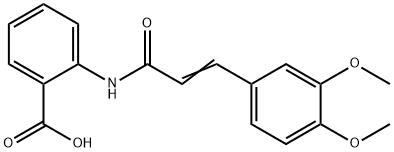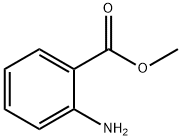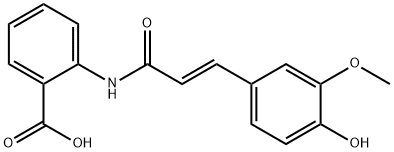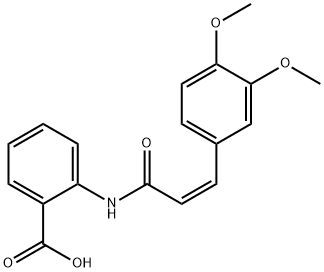Tranilast
Synonym(s):3,4-DAA;N-(3?,4?-Dimethoxycinnamoyl)anthranilic Acid;N-(3,4-Dimethoxycinnamoyl)anthranilic acid;Rizaben;2-[[3-(3,4-Dimethoxyphenyl)-1-oxo-2-propenyl]amino] benzoic acid
- CAS NO.:53902-12-8
- Empirical Formula: C18H17NO5
- Molecular Weight: 327.33
- MDL number: MFCD00864787
- SAFETY DATA SHEET (SDS)
- Update Date: 2025-12-16 16:15:04

What is Tranilast?
Description
Tranilast (53902-12-8) is an anti-allergy agent (inhibitor of mast cell degranulation) that has been shown to have potent immunomodulatory effects via inhibition of endotoxin induced: PGE2, IC50 = 1-20 μM; TXB2, IC50 = 10-50 μM; TGFβ1, IC50 = 100-200 μM; IL-8, IC50 = 100 μM .1-3 Tranilast also displays anti-angiogenic properties.4,5
Chemical properties
Pale Green Solid
Originator
Rizaben,Kissei Pharmaceutical Co., Ltd.,Japan,1982
The Uses of Tranilast
Tranilast is a compound that exhibits anti-inflammatory and immunomodulatory effects by inhibiting lipid mediator and cytokine release from inflammatory cells and interfering with PDGF- and TGF-β1-induced proliferation and migration of vascular medial smooth muscle cells. Tranilast suppresses production of prostaglandin D2 (IC50 = 0.1 mM), prostaglandin E2 (IC50 = ~1-20 μM), thromboxane B2 (IC50 = ~10-50 μM), TGF-β1 (IC50 = ~100-200 μM), and interleukin-8 (IC50 = ~100 μM) in in vitro models as well as attenuates of the proinflammatory activity of human monocytes. While originally marketed as an antiallergenic drug, the efficacy of tranilast in preventing restenosis after percutaneous coronary intervention has been tested in a large-scale clinical trial. Additionally, tranilast inhibits VEGF-induced angiogenetic activities (i.e., proliferation, migration and tube formation of vascular endothelial cells) with IC50 values of 22, 18 and 193 μM, which may prove therapeutic for various retinal diseases.[Cayman Chemical]
The Uses of Tranilast
Antiallergic drug, used to treat bronchial asthma, allergic rhinitis and atopic dermatitis.
The Uses of Tranilast
coronary vasodilator
What are the applications of Application
Tranilast is an inhibitor of angiogenesis and the release of histamine and prostaglandins
Definition
ChEBI: An amidobenzoic acid that is anthranilic acid in which one of the anilino hydrogens is replaced by a 3,4-dimethoxycinnamoyl group.
Manufacturing Process
4 g of 3,4-dimethoxycinnamic acid was dissolved in 20 ml of dry pyridine. To
this solution were added under cooling with ice and agitation 2 g of
benzenesulfonyl chloride whereby a red orange precipitate was formed. The
reaction mixture was stirred for about one hour and then 2 g of methyl
anthranilate were added to the mixture under cooling with ice. The mixture
was stirred for 2 hours at room temperature to complete the reaction. After
completion of the reaction, the reaction mixture was concentrated and the
residue was taken up in about 10 ml of chloroform. The solution was washed
first with a 10% aqueous solution of caustic soda, then with a 10% aqueous
solution of hydrochloric acid and finally with water and then distilled to
remove chloroform whereby crystals of N-(3',4'-dimethoxycinnamoyl)-
anthranilic acid methyl ester were obtained.
This product was dissolved in 10 ml of chloroform. To this solution were added
10 ml of a 10% aqueous solution of caustic soda and the mixture was warmed
at 50°C to effect hydrolysis of the ester group. After completion of the
reaction, the organic phase was separated, washed with water and distilled to
remove the solvent whereby 2.1 g (yield: 48%) of the end product, i.e., N-
(3',4'-dimethoxycinnamoyl)-anthranilic acid, were obtained. This product had a melting point of 211°C to 213°C
Therapeutic Function
Antiallergic
Biological Activity
Antiallergic via inhibition of chemical mediator release from mast cells. Most recently shown to be an effective inhibitor of angiogenesis. Demonstrated to antagonize the effects of angiotensin II on human arteries, possibly by an interaction at the level of the AT 1 receptor.
Biochem/physiol Actions
Tranilast also inhibits vascular smooth muscle cell proliferation by inhibiting the cyclin-dependent kinase inhibitor-1(p21Waf1/Cip1) and may be useful in treating cardiac allograft vasculopathy. It is used in treating hypertrophic scars and keloids. Tranilast inhibits tumor necrosis factor (TNF-α and TGF-β2), obstructing epithelial-mesenchymal transition in human retinal pigment epithelial cell line (ARPE).
Storage
Room temperature
References
1) Capper et al. (2000) Modulation of human monocyte activities by tranilast, SB252218, a compound demonstrating efficacy in restenosis; J. Pharmacol. Exp. Ther., 38 2673 2) Ward et al., (2002) Tranilast prevents activation of transforming growth factor-b system, leukocyte accumulation and neointimal growth in porcine coronary arteries after stenting; Arterioscler. Thromb. Vasc. Biol., 22 940 3) Chikaraishi et al. (2001) Tranilast inhibits interleukin-1b-induced monocyte chemoattractant protein-1 expression in rat mesangial cells; Eur. J. Pharmacol., 427 151 4) Isaji et al. (1997) Tranilast inhibits the proliferation, chemotaxis and tube formation of human microvascular endothelial cells in vitro and angiogenesis in vivo; Br. J. Pharmacol., 122 1061 5) Koyama et al. (1999) Tranilast inhibits protein kinase C-dependent signaling pathway linked to angiogenic activities and gene expression of retinal microcapillary endothelial cells; Br. J. Pharmacol., 127 537
Properties of Tranilast
| Melting point: | 166.2-168.2 °C (lit.) |
| Boiling point: | 465.23°C (rough estimate) |
| Density | 1.3185 (rough estimate) |
| refractive index | 1.5100 (estimate) |
| storage temp. | 2-8°C |
| solubility | DMSO: 18 mg/mL |
| form | powder |
| pka | 3.47±0.36(Predicted) |
| color | white to beige |
| Merck | 14,9570 |
| Stability: | Stable for 1 year from date of purchase as supplied. Solutions in DMSO may be stored at -20° for up to 3 months. |
| CAS DataBase Reference | 53902-12-8(CAS DataBase Reference) |
Safety information for Tranilast
| Signal word | Warning |
| Pictogram(s) |
 Exclamation Mark Irritant GHS07 |
| GHS Hazard Statements |
H302:Acute toxicity,oral |
| Precautionary Statement Codes |
P264:Wash hands thoroughly after handling. P264:Wash skin thouroughly after handling. P270:Do not eat, drink or smoke when using this product. P301+P312:IF SWALLOWED: call a POISON CENTER or doctor/physician IF you feel unwell. P501:Dispose of contents/container to..… |
Computed Descriptors for Tranilast
| InChIKey | NZHGWWWHIYHZNX-CSKARUKUSA-N |
Tranilast manufacturer
New Products
Indole Methyl Resin tert-butyl 9-methoxy-3-azaspiro[5.5]undecane-3-carboxylate Boc-His(Boc)-OH 2-CTC Resin 4-Chloro-7-tosy1-7Hpyrrolo[2,3-d]pyrimidine 5,7-Dibromo-1H-indole 2,5-dichloro-N-hydroxy-4,6-dimethylpyridine-3-carboximidamide 2,2-Dimethoxy-7-azaspiro[3.5]nonane hydrochloride 4-chloromethyl-5-methyl-1,3-dioxol-2-one (DMDO-Cl) R-2-BENZYLOXY PROPIONIC ACID 1,1’-CARBONYLDIIMIDAZOLE 1,1’-CARBONYLDI (1,2-4 TRIAZOLE) N-METHYL INDAZOLE-3-CARBOXYLIC ACID 4-((2-hydroxyethyl)thio)benzoic acid 1-(TERT-BUTOXYCARBONYL)-2-PYRROLIDINONE Methyl 6-methylnicotinate 3-Pyridineacrylic acid tert-Butyl carbazate TETRAHYDRO-2H-PYRAN-3-OL 2-((4-morpholinophenylamino) (methylthio) methylene) malononitrile 3-(4-morpholinophenylamino)-5-amino-1H-pyrazole-4-carbonitrile 2,4-dihydroxybenzaldehyde 1,3-Diethyl-1,3-Diphenylurea Methyl 2-methylquinoline-6-carboxylateRelated products of tetrahydrofuran








You may like
-
 53902-12-8 Tranilast 98%View Details
53902-12-8 Tranilast 98%View Details
53902-12-8 -
 53902-12-8 98%View Details
53902-12-8 98%View Details
53902-12-8 -
 Tranilast CAS 53902-12-8View Details
Tranilast CAS 53902-12-8View Details
53902-12-8 -
 Tranilast 98% (HPLC) CAS 53902-12-8View Details
Tranilast 98% (HPLC) CAS 53902-12-8View Details
53902-12-8 -
 Tranilast >98% (HPLC) CAS 53902-12-8View Details
Tranilast >98% (HPLC) CAS 53902-12-8View Details
53902-12-8 -
 Tranilast 95.00% CAS 53902-12-8View Details
Tranilast 95.00% CAS 53902-12-8View Details
53902-12-8 -
 Tranilast CAS 53902-12-8View Details
Tranilast CAS 53902-12-8View Details
53902-12-8 -
 Thiourea 99% ARView Details
Thiourea 99% ARView Details
62-56-6
